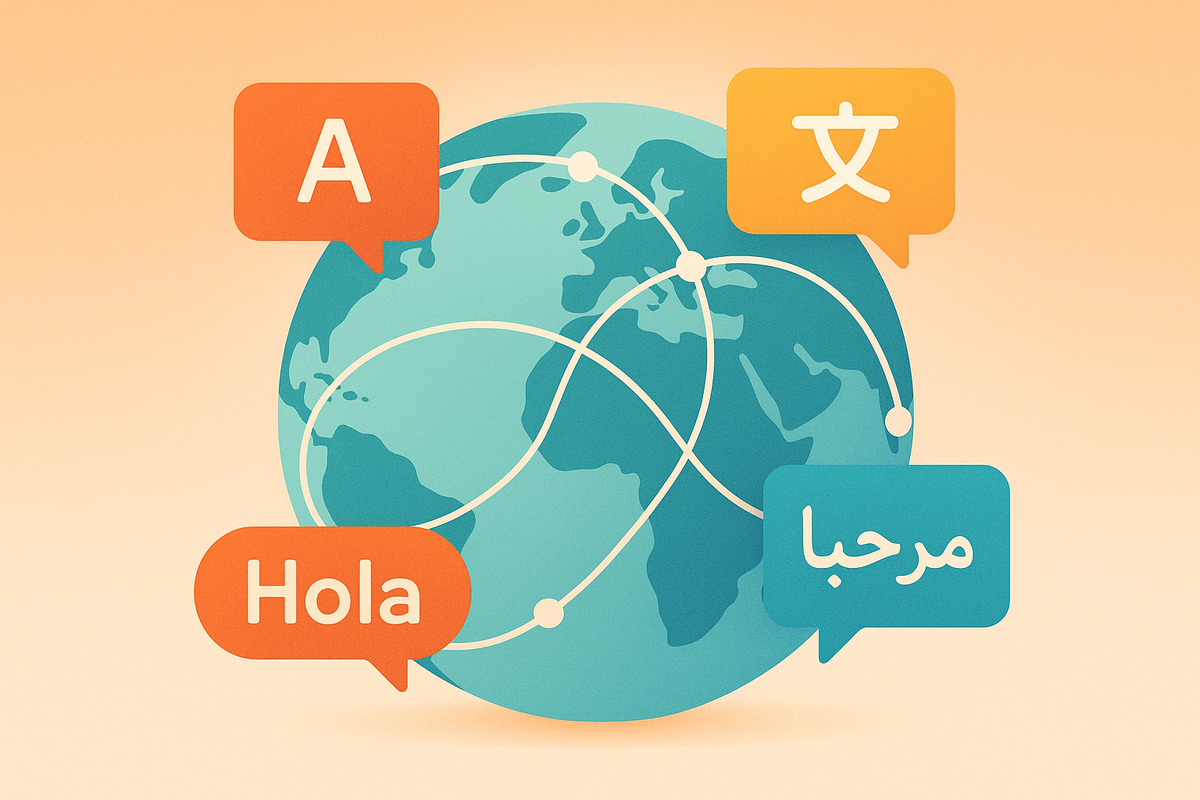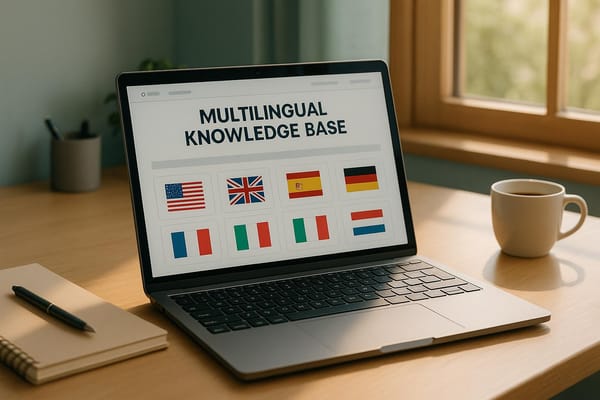5 Challenges in Multilingual Support and Fixes
Explore the top challenges in multilingual support and effective AI-driven solutions to enhance customer experience across languages.

Want to improve multilingual support for your business? Start here.
Handling customer support in multiple languages can be tough. But with the right tools, you can tackle common challenges like inconsistent translations, regional differences, and high costs. Here’s a quick breakdown of the five biggest hurdles and how to fix them:
- Language Consistency: Use an AI-driven knowledge base to ensure uniform messaging across languages.
- Translation Accuracy: Combine AI translations with human reviews to avoid errors and misinterpretations.
- Regional Differences: Adapt communication styles using AI tools that detect cultural preferences.
- Quality Control: Pair AI monitoring with native-speaking reviewers to maintain high standards.
- Budget Management: Leverage AI chatbots and automated workflows to cut costs while scaling support.
With AI and automation, you can deliver accurate, reliable, and efficient multilingual support, helping your business grow globally while keeping customers happy.
Challenge 1: Language Consistency Issues
Problem: Mixed Messages Across Languages
Maintaining consistent brand messaging across multiple languages can be a tough task. Companies often find it challenging to keep their voice and terminology uniform, leading to confusion and eroding customer trust. This issue isn't just about literal translation - it’s about preserving the essence of the brand.
When technical terms are translated inconsistently across knowledge base articles, it can cause several problems:
- Confusion about product details, leading to more support tickets
- Longer resolution times as agents clarify unclear terms
- Loss of customer trust in the brand
- Increased chances of miscommunication in critical scenarios
Solution: AI-Powered Knowledge Base
The best way to address this issue is by centralizing multilingual support content through an AI-driven knowledge base. This ensures all translations come from a single, consistent source, keeping messaging uniform across languages.
AI tools make managing multilingual content easier than ever. For example, HelpJam's Knowledge Base feature allows teams to:
- Write content once and translate it automatically with consistent terminology
- Use AI tools to create translations in seconds
- Adjust the knowledge base to reflect the brand’s identity in every language
- Handle unlimited articles and categories across multiple languages from one platform
This method combines the speed and accuracy of AI with human refinement. AI handles the heavy lifting, while teams review and adjust to ensure the brand's voice stays intact.
Here’s how to get started:
- Create a Glossary: Build a centralized database of key terms and their approved translations.
- Leverage AI Tools: Use AI for consistent translation of technical terms.
- Conduct Regular Audits: Periodically review translations to ensure they meet brand standards.
Challenge 2: Machine Translation Accuracy
After addressing consistency, ensuring precise translations remains a major challenge.
Problem: Translation Errors
Machine translation often struggles with technical support content, leading to customer confusion. Common problems include:
- Context Misinterpretation: AI can overlook subtle nuances, which is especially problematic in technical documentation where accuracy is crucial.
- Technical Term Misuse: Specialized industry terms may be translated literally, resulting in unclear or incorrect explanations.
- Idiomatic Errors: Common support phrases or jargon often translate poorly, leading to confusing or misleading instructions.
These challenges call for a blend of technology and human expertise.
Solution: Combining AI and Human Oversight
Achieving better translation accuracy requires a mix of automation and expert review. Here’s how to approach it:
Step 1: AI for Initial Translation
Leverage AI tools to quickly generate consistent translations.
Step 2: Human Review for Refinement
Engage native technical experts to:
- Check technical terms for accuracy
- Adjust language to ensure it fits the context
- Confirm the translation aligns with cultural nuances and the brand’s tone
- Update an evolving glossary and translation memory for continuous improvement
Using tools like HelpJam's multilingual knowledge base, teams can automate initial translations while streamlining the review process. This method ensures support articles are accurate, culturally relevant, and aligned with customer expectations, all while improving operational efficiency.
Challenge 3: Regional Communication Differences
Handling regional communication differences goes beyond accurate translation - it involves meeting distinct cultural expectations that can vary widely.
Problem: Communication Style Gaps
Regional differences in communication styles can create challenges during support interactions:
- Direct vs. Indirect Communication: Some regions value straightforward responses, while others lean towards more relational, nuanced dialogue.
- Response Time Expectations: In certain cultures, quick replies are crucial, while others prioritize detailed, well-thought-out solutions over speed.
- Formality Levels: What feels professional in one region might come across as too detached or overly casual in another.
These gaps highlight the need for tailored approaches to ensure effective customer support.
Solution: Region-Specific Support Methods
Addressing these differences requires blending technology with cultural awareness:
- Automated Cultural Detection: AI tools can identify a customer's location and browser settings to adjust greetings, tone, and response times instantly.
- Customized Support Interfaces:
- Chatboxes designed to meet local preferences
- Knowledge base articles rewritten to align with regional communication styles
- AI-generated content that respects cultural nuances
- Smart Routing System: Automatically direct customer inquiries based on their location, language, time zone, and preferred communication style to ensure quicker and more relevant solutions.
Implementation Strategy
Leverage AI tools to:
- Translate content while respecting cultural nuances.
- Create responses tailored to specific regional preferences.
- Analyze customer interactions to refine cultural alignment.
- Build detailed customer profiles based on location and individual preferences.
Challenge 4: Quality Control Across Languages
Ensuring consistent quality across multiple languages can be tough, especially when leaders aren't fluent in all the supported languages. Without the proper tools, it’s easy to overlook context or apply inconsistent standards. Combining AI tools with expert human reviewers can help maintain reliable, culturally aware support.
Problem: Limited Language Expertise
When supervisors lack fluency in certain languages, they may miss key details, delay feedback, or struggle to enforce consistent quality standards.
Solution: AI Tools and Native Reviewers
By pairing AI-driven tools with native-speaking experts, businesses can improve multilingual quality control.
AI-Powered Quality Management
AI can help by:
- Summarizing conversations
- Providing real-time quality metrics
- Highlighting inconsistencies for further review
Strategic Implementation
- AI-Enhanced Review Process
AI monitors conversations, flags potential issues, generates quality reports, and offers automated proofreading in multiple languages. - Native Reviewer Team
Human reviewers step in to validate flagged issues, conduct quality assessments, and suggest language-specific improvements. - Integrated Quality Dashboard
A centralized dashboard tracks metrics, identifies trends, and measures the success of improvement efforts.
| Component | AI Role | Human Role |
|---|---|---|
| Content Review | Checks for consistency | Validates cultural nuances |
| Performance Monitoring | Detects issues in real time | Conducts quality assessments |
| Knowledge Management | Identifies gaps | Refines and updates content |
This approach ensures that businesses can deliver high-quality support in every language while balancing efficiency with cultural accuracy.
Challenge 5: Budget and Resource Management
Once quality control is addressed, managing budgets becomes the next hurdle. Supporting multiple languages can quickly strain financial and human resources.
Problem: High Support Costs
The costs of multilingual support can add up due to several factors:
Staffing
- Training and managing agents who can handle multiple languages
- Ensuring global coverage across various time zones
Technology
- Paying for translation software licenses
- Integrating these tools with existing platforms
Content
- Keeping knowledge bases updated in multiple languages
Solution: Smarter Resource Allocation with AI
To tackle these rising costs, turn to AI for efficient resource management.
Automated Support Systems
AI-powered chatbots can manage routine questions around the clock, ensuring consistent service in multiple languages without the need for additional staff.
Resource Optimization Strategies
- AI-Driven Knowledge Base: Build a multilingual knowledge base to let users find answers on their own.
- Smart Workflow Automation:
- Automatically route tickets based on language
- Provide AI-suggested responses for faster resolutions
- Enable real-time translation for seamless communication
- Flexible Support Scaling:
- Begin with key languages that match your audience’s demographics
- Gradually add more languages as demand grows
- Use AI insights to guide expansion decisions
Cost-Effective Implementation
Platforms like HelpJam offer AI-powered solutions that cut down on manual translation efforts while enhancing support efficiency. This approach helps balance costs and maintain high-quality service.
Conclusion: Using AI to Improve Multilingual Support
AI-driven multilingual support tackles key challenges while cutting costs. From maintaining consistency and accuracy to addressing regional differences and managing resources, AI provides precise solutions. Today’s platforms enable businesses to offer reliable, high-quality support in multiple languages without the usual overhead.
AI has reshaped daily operations, allowing support teams to concentrate on complex problems while automated tools handle routine tasks like translations and basic communications. This setup ensures round-the-clock support across all languages and time zones, improving both team productivity and customer experience.
With these tools, businesses can implement scalable and cost-effective solutions for teams of any size, paving the way for growth that aligns with demand. As workflows become more efficient, businesses are better equipped to evolve their support systems for the future.
AI has also revolutionized quality assurance in multilingual support. Automated translations, real-time checks, and in-depth analytics ensure consistent quality across all languages, all while keeping operations running smoothly.
Emerging AI features are shaping the future of multilingual support, including:
- AI Co-pilots to simplify support processes
- Customizable knowledge bases that handle extensive content needs
- Real-time analytics for optimizing performance
These advancements empower businesses to provide outstanding multilingual support while staying efficient and prepared for growth.
FAQs
How does AI improve translation accuracy and consistency in multilingual customer support?
AI enhances translation accuracy and consistency by leveraging advanced machine learning models trained on your business's knowledge base, documents, and other resources. This ensures responses are contextually accurate and aligned with your brand's tone and terminology.
Additionally, AI tools can automatically detect and adapt to language nuances, reducing errors and maintaining uniformity across all customer interactions. This helps streamline multilingual support while improving customer satisfaction.
How can businesses handle regional communication differences in multilingual customer support?
Managing regional communication differences in customer support is critical for delivering a personalized experience. With HelpJam's multilingual knowledge base, businesses can create and manage articles in multiple languages, ensuring customers have access to relevant information in their preferred language.
Additionally, HelpJam's fully translatable chatbox allows customers to interact in their native language right from the start, creating a seamless and inclusive support experience. These tools empower businesses to bridge language gaps and build stronger connections with their global audience.
How can AI-powered tools help reduce costs in multilingual customer support?
AI-driven tools can significantly lower costs in multilingual support by automating repetitive tasks and reducing the need for extensive manual labor. For example, AI chatbots can handle common queries in multiple languages, allowing support agents to focus on more complex issues. This not only saves time but also minimizes the need for hiring additional multilingual staff.
Additionally, AI tools like automated translation and multilingual knowledge bases ensure consistent, accurate responses across languages without requiring constant human intervention. These solutions streamline operations, improve efficiency, and ultimately help businesses cut down on operational expenses while maintaining high-quality support.





